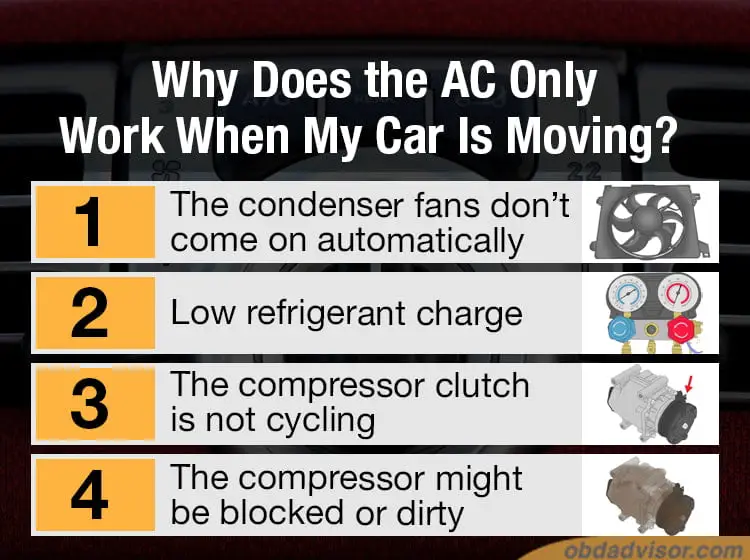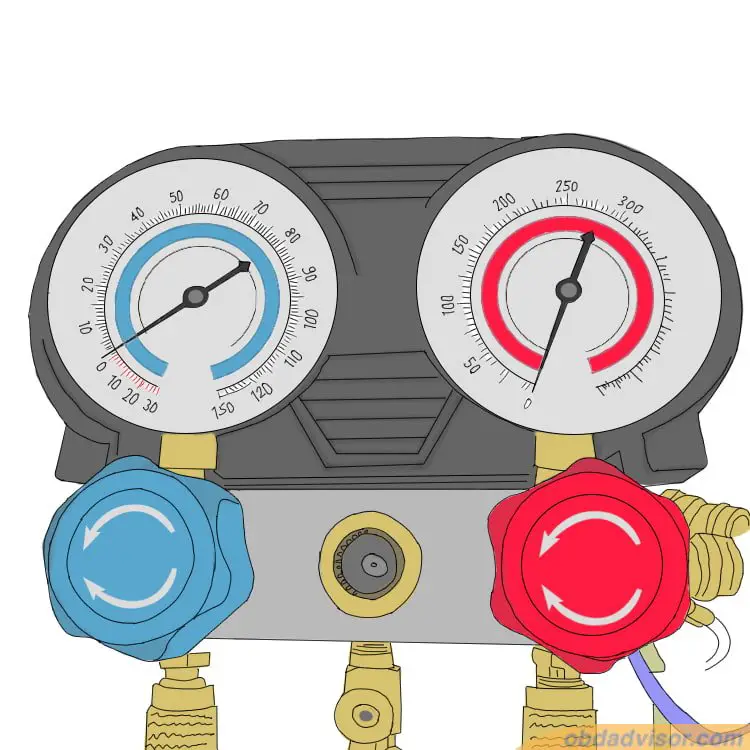At times it’s frustrating when the air conditioning only works while the car is moving and doesn’t when parked, especially when the atmospheric conditions are hostile to you.
Often, it’s a minor issue that you can quickly fix, especially if you’re a hands-on person when it comes to vehicles.
This post will highlight 4 possible reasons for this issue and their solutions.
- Cause #1: The condenser fans don’t come on automatically
- Cause #2: The refrigerant charge is low
- Cause #3: The compressor clutch is not cycling
- Cause #4: The compressor might be blocked or dirty
Hopefully, I might save you a needless visit to the mechanic that could be overly expensive.
Let’s dig into it!
The AC Only Works When Your Car Is Moving: Top 4 Reasons Explained And The Solutions
Note: The problem is sometimes caused by the combination of more than 1 factor.

Cause #1: The condenser fans don’t come on automatically
Further explanation
Condense fans are responsible for transferring the heat from the refrigerant system into the outdoor air. After leaving the condenser, the refrigerant moves to the orifice tube or expansion valve and then the evaporator coil.
So, the purpose of the condenser fans is to reduce the temperature of the refrigerant so it can condense.
They are designed to rotate when the engine reaches its optimal operating temperature, about 195°F to 220°F. This function is to monitor the engine’s temperature by using its switch.
When failure occurs, proceed by checking the relays and fuses of the condenser fan.
Additionally, troubleshoot the wiring to the vehicles for corroded or loose connections, short and open circuits. The instances that reflect the fan socket is getting adequate current, indicating that the fan is dead.
A couple of reasons might kill the fan, including a faulty temperature switch, or a defective coolant sensor. Or sometimes, the engine thermostat might be stuck OPEN, meaning that it never gets hot enough to trigger the fan.
Furthermore, a faulty fan control module and a dysfunctional fan motor might be the cause of all your turmoil.

Solution
The easiest and fastest way to troubleshoot issues related to the fan circuit is to crank the engine and switch the AC to MAX.
A rotating fan indicates that the fan motor and the wiring, including the fuses and relays, are perfect. However, the test provides insufficient information to rule out issues related to the temperature sensor and PCM.
If you’re having doubts about the temperature sensor, check its resistance using a multimeter. Furthermore, the multimeter can help you check for blown fuses, bad relays and check continuity in the wiring to your fan.
Jumper cables are your saving grace when it comes to troubleshooting the fan motor. You can rule out this issue by unplugging the wiring connections to the fan and using jumper cables from the battery to direct power to the fan.
Finding the best jumper cable for your vehicle, don’t miss my review on it.
A functional fan motor will run flawlessly at average speed. Contrarily, a faulty fan motor will run slower than expected even after being supplied with 12V of power.
Replace the faulty components, including the sensors, thermostat, relays, and fuses, to return the vehicle’s AC functioning to normalcy.
For the fan motor, you can get a replacement or have it rebuilt by a trusted mechanic.
Wiring issues can be corrected by tightening bolts and nuts to prevent loose connections. Additionally, pouring a water mixture with baking soda into the corroded wires will remove the corrosion.
Cause #2: The refrigerant charge is low
Further explanation
Vehicle manufacturers use a low-pressure switch to prevent the compressor from running if the system is low on refrigerant. Moreover, AC compressors will require a constant oil supply to prevent catastrophic failure.
Solution
To troubleshoot errors denoting to low refrigerant charge, follow these guidelines:
- Step 1: Crank the engine, roll down all the windows, and switch on the AC.
- Step 2: While the engine idles, with the blower speed set at 2, allow a minimum of ten minutes for the engine to reach its optimal operating temperatures.
- Step 3: Study the AC pipe in the engine compartment for moisture and note the temperature. The pipe should feel cold and condensed water visible over it.
- Step 4: Check the same pipe near the firewall. If you notice that it’s cooler, then there is a possibility of low gas volume.

Mechanics use a two-dial pressure gauge to determine the gas volume of your refrigerant. The device is connected to the high pressure (HP) and low pressure (LP) lines to take the readings.
It’s a relatively easy task that you can accomplish by yourself. Refilling the depleted refrigerant will be the way to go.
If the issue is only about low evaporator pressure, the better solution is recharging it through the low-pressure port while the compressor is still engaged. In this scenario, you should use DIY recharging kits. However, low refrigerant levels will result in the clutch never engaging.
Note: It’s bad practice to hotwire the low-pressure switch to force the compressor clutch to engage while you recharge. As you may be running the compressor with little to no oil. It might accept the charge, but it will cost you the compressor.
Recharge the freon in your AC if you know the procedure. Otherwise, it is preferable to seek professional help.
Don’t miss 3 of the best freon refrigerants in the market if you want to recharge by yourself.
ZeroR EZ Chill R134a freon refrigerant

AC Pro Car AC R134A freon refrigerant

Chemours Freon R134a freon refrigerant

[Video] How to recharge the freon refrigerant in your car AC:
Cause #3: The compressor clutch is not cycling
Further explanation
The compressor clutch is responsible for engaging the compressor shaft. If it fails, the air conditioning compressor can’t pump refrigerant.
To determine whether the compressor clutch works, turn the AC to MAX and crank the engine. The pulley and the clutch should spin in unison at this stage.
There is a severe fault with the system when only the pulley is rotating. The clutch might fail to engage because of several reasons.

An open circuit resulting from broken wire to the clutch coil, blown fuses, a fault clutch coil, or poor ground might be the cause. It could also be a low-pressure lockout that is causing all the trouble. All in all, use a multimeter to narrow down the faulty components.
Solution
Replace the faulty component to resume the regular running of your car.
You can eliminate issues about loose connections by tightening the respective nuts and bolts.
You can handle grounding issues by revising the wiring, thus correcting the error resulting from the live wire’s contact with the earth wire.
Cause #4: The compressor might be blocked or dirty
Further explanation
The compressor is tasked with circulating the refrigerant between the evaporator and the condenser coils.
You can identify leakages by performing a visual check on the AC line, condenser, and compressor. You will notice accumulated dust that results from sedimentation of oil around the leaking lines.
Ensure that you check the AC filter as it might be clogged due to dust accumulation.

Solution
Using a pressure washer, wash the condenser through the openings in the bumper.
Suppose you notice muddy water dripping down; it means that the compressor is clogged. Be cautious not to point the washer jet over the condenser as it’s susceptible to damage. Instead, spread it out.
Perhaps it would be a better option if you took your vehicle to a washing center and have them wash the radiator carefully for you. Your car AC will resume normal functioning after this.
Bonus: Want to know the OBD2 codes related to your AC system? Search AC system OBD2 codes here
Conclusion
With the 4 reasons that I’ve mentioned above, I hope you can identify exactly the cause of your AC only getting cold while driving and fix it immediately.
In some cases, you might need to do a visual test and cleaning. You should take your car to a mechanic, though, if you are unable to fix it yourself.
Now I’d like to hear your thoughts:
Which one is the cause of your AC not working? Do you know any other reasons?
Let me know by leaving a comment below right now.
Learn more
How Long Can I Drive With A Misfiring Cylinder? This post shows you what to do if you think your car’s having this problem.
Do I need to add oil when recharging my car’s AC compressor?: Like the name suggests, this article will help you to know if you should add oil when recharging AC or not.
Bluedriver: This is one of the best Bluetooth scanners that help you to read OBD2 codes related to your AC system.